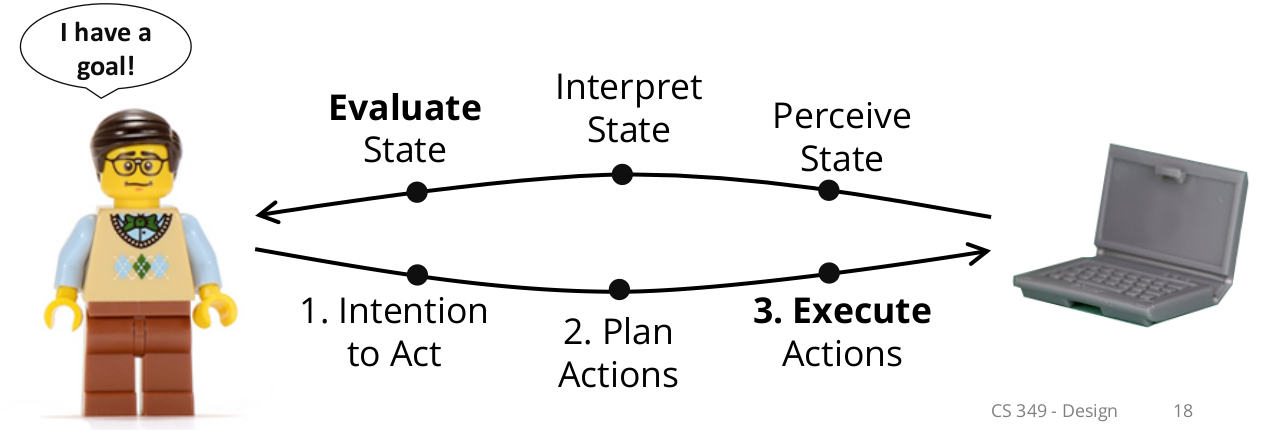User-Centred Design
Usability - the effectiveness, efficiency, and satisfaction with which user can achieve task in a particular environment with a product
Usefulness - meeting specific needs and supporting real tasks; the quality of being practical use

User Mental Model
- What user believes about the system
- Frequently, and mental model is inaccruate or incomplete compared to system model
- e.g. A fridge and freezer has separate temperature controls (mental model), but it actually has one temperature control and a cold air valve (system model)
Three Models of a System
- Developer's model - how the developer believes system is used
- System model - how the system actually works
User's model - how the user believes the system should be used
Developer and user communicate through the system, and the goal is to align them as closely as possible
Norman's Model of Interaction
- Execution - what we do to the system to achieve a goal
- Evaluation - comparing what happened with our intended goal
| Execution Stages | Evaluation Stages |
|---|---|
| 1. Form an intention to act to achieve a goal | 1. Physically perceive the current state of thes system |
| 2. Plan an sequence of actions to fulfill that intention | 2. Interpret that preception according to experience |
| 3. Execute planned actions with physical movements | 3. Evaluate the iterpreted state compared to our goal |
- Gulf of execution - difficulty translating user's intentions into actions allowed by system (the execution stages)
- Gulf of evaluation - difficulty in interpreting the state of the system to determine whether our goal has been met (the evaluation stages)
Central Tension
- User - rich and varied experiences; make intuitive leaps; leans; uses metaphors; creative
- System - follows a rigid program; not creative; only primitive learning (at best)
- User Interface - needs to mediate between these two radically different systems
UI Design Principles
- Basic principles which reduce gulf of execution and evaluation and create a more correct mental model for user
Perceived Affordance
- What you think you can do with an object based on preceived properties
- Influenced by
- Individual histories
- Cultural background
Mappings
- The relationship between two things, between the control movement and the results in the world
- Doors: bars/plates for pushing, handles for pulling
UI Mappings
- Physical actions of input device mapped to UI instrument
- Instrument actions mapped to object of interest
Literal Mapping
- Some things work well in phsyical world, but not in virtual
- e.g. dials
Constraints
- Guide by preventing certain actions while enabling/encouraging others
- Physical constraints
- Semantic constraints
- Cultural constraints
- Logical constraints
Visibility
- Make relevant parts visible and convey the correct message
- Make controls visible, either on-screen or in menus; list keyboard short-cuts in menus
- Communicating what action has actually been done; what result has been accomplished
- Every action should give feedback. Give progress indicator if it can't be completed immediately
Metaphors
- Set of unifying concepts in a GUI used to simplify interaction with a computer system
- Done by borrowing concepts from one domain (the source or vehicle) and applying them to another (the target or tenor)
- Scale can vary from system to application to UI feature
Benefits
- Common language for objects
- Window, Recycle Bin/Trash, Folder, Files
- Guide for congnitive semantics of system
- Windows => look into a house => look into a document
- Recyling => reclaim garbage
- Analogy to explore similarities and differences
